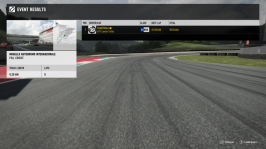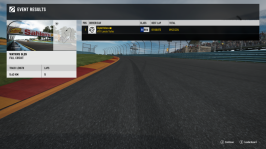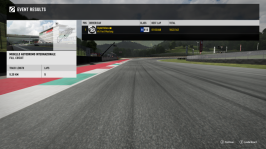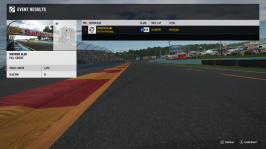A showdown between two of my favorite racecars of all times, on two of my favorite tracks? How could I say no? As a matter of fact, why limit myself to lapping the Beta in Italy, and the Mustang in the US? Let's turn this into a full-blown head-to-head comparative test!

There are not many manufacturers that can claim a motorsport tradition as rich and varied as Lancia. You'd be excused, then, for not being familiar with the history of the gorgeous Group 5 Beta Montecarlo, a car that brought to Turin many victories in its three years of activity. By the end of the 1970s, the Stratos was starting to show the signs of its age, and thus Lancia set to work to find a suitable replacement, with both the World Rally Championship and sportscar racing in mind (where the wedge-shaped, Ferrari-powered car, bestowed with the dark magic of a single KKK turbocharger, collected a series of disappointing retirements). The Beta Montecarlo, which had been introduced to the Lancia lineup in 1975, seemed the most obvious choice: originally intended as a replacement for the Fiat 124 Sport, the Pininfarina-designed mid-engined sportscar was always destined to become a racing machine, and Abarth had already begun development of an experimental Group 4 prototype, the SE030, which had shown much promise at the 1974 Giro d'Italia motor race. Dallara was tasked with developing the chassis, and quickly replaced the front and rear subframes with lightweight tubular elements; Pininfarina redesigned the bodywork, making extensive use of lightweight composite materials and windtunnel testing. Fearful of Porsche's utter domination of Division 1 of the World Sportscar Championship, where the 935 was
scalping the competition, Lancia decided to stick to Division 2, intended for cars with an engine displacement below 2 litres (or 1.4 for turbocharged cars): the flat-4 engine of the Gamma was briefly considered as a power source for the Beta, but in the end a brand-new DOHC inline-4, capable of 480 hp in racing trim and over 500 at maximum boost, found its way behind the cockpit of the car.

A team of impressive drivers was soon assembled, and it included rally champion Walter Rohrl, future F1 aces such as Riccardo Patrese, Michele Alboreto and Eddie Cheever, and a promising young driver by the name of Emanuele Pirro amongst many other names that undoubtedly showed the seriousness of the challenge for the World Sportscar Championship title Lancia was mounting. Already in the 1979 debut season, and despite some obvious teething problems, the Beta Montecarlo was the car to beat in Division 2, handily dominating over a sea of BMW 320s. But 1980 would be the
annus mirabilis of Lancia in sportscar racing: in a grueling, 11-races championship that included the Daytona and Le Mans 24h races, the team would not only win all of the Division 2 races but one, but it would also go on to collect a Division 1 victory thanks to a Beta powered by a 1,7 litres engine. At the end of the season they had the same number of points as Porsche; but with one more class victory, they could claim the World Championship for Makes. 1981 would see Lancia repeat its performance, but sadly, the era of Group 5 was coming to a close, and in 1982 the "production special" machines would leave room to the Group C prototypes that would define racing in the 80s. Lancia's competitor in the class, the Ferrari-powered LC2, was incredibly quick, often stealing the pole from the seemingly-unbeatable 962s, but its poor reliability relegated it "best of the rest" status. The lessons learned with the Beta were also put to use somehwere else: the chassis of the 037, Lancia's iconic Group B rear wheel drive monster, was essentially developed from the Montecarlo's.

The Beta Montecarlo Turbo also clinched the 1980 Deutsche Rennsport Meisterschaft, with Hans Heyer behind the wheel. Amongst its Division 2 competitors were the outrageous Capris built by Zakspeed, one of the winningest names in GT and Endurance racing. After Ford shut down its European racing programme in the wake of the oil crisis of the early 1970s, Erich Zakowski's racing team had become the
de facto official racing arm of Ford Germany, establishing the dominance of the Blue Oval brand in the earliest season of the DRM series. When the series adopted FIA Group 5 rules in 1977, the team initially tried to develop the second-generation Escort, fitting it with the usual assortment of box-flares and snowplow-like front air dams, but the naturally aspirated
BDA engine, with its power output of 280 hp, put it at a severe disadvantage against the turbocharged BMW 320s, which would be crowned Division champions at the end of the year. For the 1978 season, Zakspeed set to work on building one of the most iconic machines of the Group 5 era. The only thing the Capri had in common with its street-legal sibling were the side doors, and the greenhouse; only, in this case they were fitted on a tube frame chassis, draped in a very low-slung and angular bodywork designed for maximum aerodynamic efficiency, which made the short-lived Escort look downright conservative. The 2-litre Cosworth engine was replaced with a bespoke, 1400cc unit, which in the debut season of the car produced 380 horsepower - which would eventually rise to well over 500. But despite all the promise shown by the machine, Zakspeed would only clinch the overall title in 1981, the final year the DRM series was run to Group 5 rules.

However, it wasn't the
Wundercar's time to leave the scenes yet: that same year, the German firm would become involved in Ford's plans to join the premiere American sportscar racing series of the time, the IMSA GTX. The roof and aesthetic trimmings of the super-Capri were replaced to make it look like a Mustang instead; the re-christened machine was entrusted to the team of Jack Roush (who would've rather had a V8-powered car), and lead-footed German Klaus Ludwig drove it on most of its sorties. While the Ford was quite speedy compared to its usual opponents, it lacked the reliability necessary to go all the way in endurance races; 1983 would see the GTX category of the IMSA series - a last holdout of the Group 5 era - get the axe, and the odd front-engined Mustang GTP car would drop the 1.4-litre engine in favor of a turbocharged BDA displacing over two litres. But Zakspeed would keep developing their power unit, which would eventually find its way in their winning Interseries contender, and later on in their (significantly less successful) F1 cars.

But enough chit-chat. Let's talk about how those two cars perform, and how they compare when pitted against each other. The numbers seem to tell the tale of a very close match-up: the Beta is one of the lightest vehicles in the history of Group 5, and as such, it has a very definite weight advantage, tipping the scales at 781 kg v. the Mustang's 898; however, the Ford makes up for it with a much higher power output, 529 horses to the 400 of the Lancia. The difference is enough to ensure the Mustang also has a better power-to-weight ratio than its Italian rival (589 to 512 hp/tonne), but it comes at a price: turbo lag. The engines share the same displacement and a very similar architecture; Zakspeed managed to squeeze more power out of its four-cyl powerplant by way of a larger turbo, which delivers higher boost pressures, but takes longer to spool up. The engine really comes alive only at 4000 rpm, which is not ideal. Comparatively, the Beta's turbo kick in at about 3000 rpm, and the power delivery is smooth enough to make the lag manageable to the point that after a couple of warm-up laps, it's a non-factor.

As far as the venues of this comparison go, the Mugello Circuit and Watkins Glen are very similar tracks, featuring noticeable elevation changes, fast, sweeping corners that are a perfect test of a car's stability, and technical sections that require a fine throttle control. And the Beta Montecarlo is a truly awesome cornering machine: of course, it takes some practise to get used to its characteristics, and especially to its slight tendency to understeer, but after you do get used to its quirks, throwing it into corners with gusto and blipping the throttle on the apex becomes a very natural exercise. Few other vehicles featured in Forza are as fun as this Lancia through the fast Biondetti chicanes of the Mugello, or the Esses up the hill at Watkins Glen.

The Mustang, on the other hand, is more finicky and nervous, but also more responsive on corner entry. It is a machine that will
eat you alive if you dare push on the throttle when the wheels are not straight, and even then, you should be careful: the comically wide rear tires may still easily lose traction, resulting in a loss of time (if you are lucky) or in an embarassing spin out. But with that being said, once you can get into your stride, it is undoubtedly the faster car of the duo: not only it will absolutely leave the Beta in the dust on the straights and on corner exit, but its light tendency to oversteer can be exploited to be even more aggressive on corner entry.

The Beta may be the most intuitive car of the duo: it doesn't take much to get into the necessary mindset to extract its full potential, but it is ultimately outpaced by the fearsome Mustang, which will really require you to be at the top of your game all the time if you don't want to end up in a wall, but will deliver stunning performance as long as you can give it your full attention. It's hard to choose between one of the two: on the single hotlap the Zakspeed car definitely takes the crown, but as far as race pace goes, the Lancia may be more consistent. In the end it boils down to personal preference: on both tracks, the two cars were separed just by a tenth of a second, with the Mustang taking the crown at the Mugello, where undoubtedly the long straight played a part in its victory, and the Beta prevailing at Watkins Glen, where it was easier to carry momentum through the slower and more technical Boot section.
 Lancia Beta Montecarlo Turbo
Pros:
Lancia Beta Montecarlo Turbo
Pros: the most malleable Group 5 car in game
Cons: a bit underpowered compared to the competition, slight tendency to understeer may lead you to overshoot corners
Laptimes
Mugello Autodromo Internazionale Full: 01:55.962
Watkins Glen Full: 01:50.872

 Ford Mustang Turbo IMSA GTX
Pros:
Ford Mustang Turbo IMSA GTX
Pros: the engine is as loud as it is powerful - and it is
very loud
Cons: requires you to keep a laser-like focus if you don't want to end up embarassing yourself
Laptimes
Mugello Autodromo Internazionale Full: 01:55.868
Watkins Glen Full: 01:50.991

 Gallery
Gallery



 )
)




 )
)




 )
) 




























